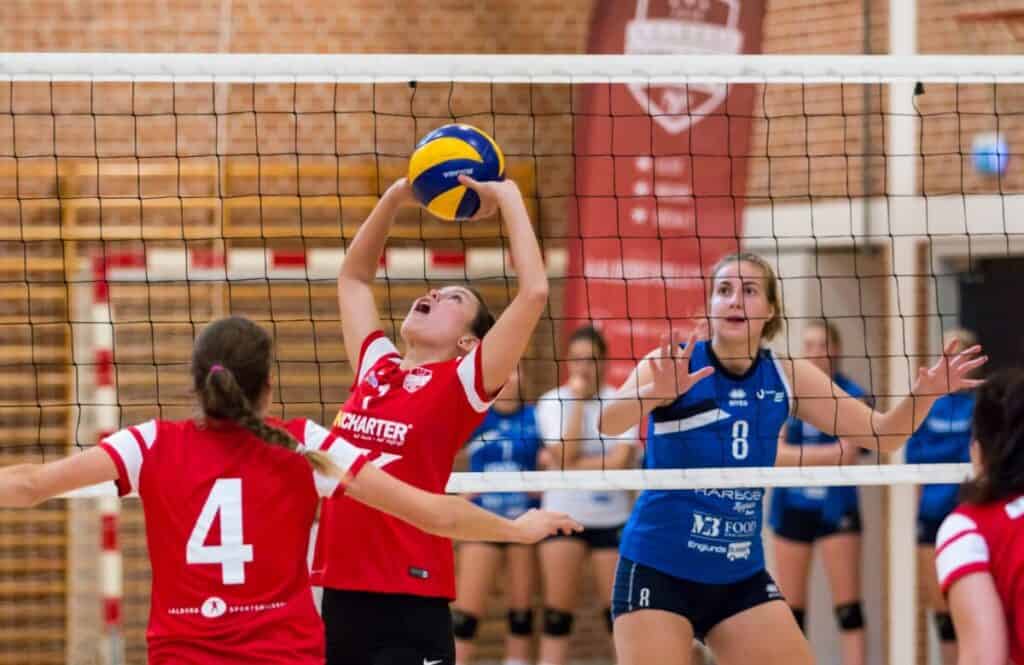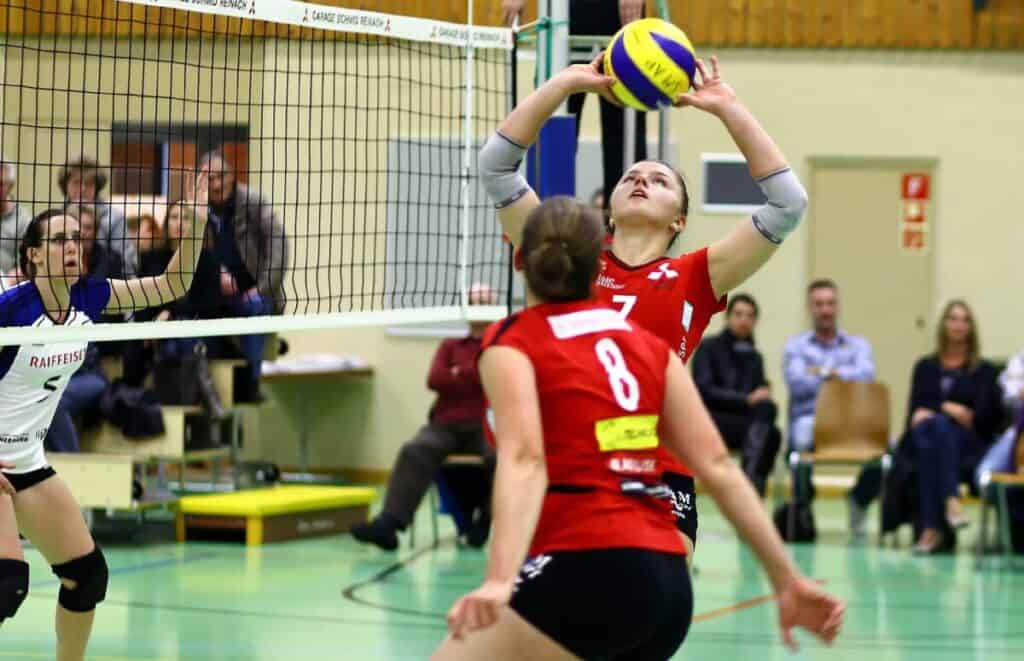You may have heard, or you may have noticed, that there’s been a change to the rule about double contact in volleyball. In 2022, an experimental rule change began to be implemented, where the double contact rule would not apply as long as the ball stayed on the same side of the net. Now, in 2024, the NCAA Women’s Volleyball Rules Committee is recommending that this become a permanent rule.
This article is meant to explore the reasons behind the rule change, the impact that the experimental rule had on the game over the past 2 years, and what it will mean for volleyball going forward.

What Was the Rule Against Double Contact Before the Change?
The rule against double contact says that a player may not touch the ball 2 times consecutively, even if those contacts are very close together – like when a player attempts to volley the ball but touches the ball slightly earlier with one hand than the other. In the early days, when the game was slower, referees would call doubles when the player obviously mistouched the ball in a way that was visible and noticeable.
In recent times, referees had been trained to call a double any time a volley (a set, or an overhand pass) would spin sideways. Although it may not have been visible to the naked eye, this was a tell-tale sign that the passer’s hands did not release the ball at exactly the same time, with the same force.
With the high-powered offenses taking over the sport over the past few decades, the rules changed to allow the first contact after a “hard-driven ball” to disregard the double contact rule. This allowed the game to be more competitive and exciting, as players could more consistently dig or save the ball after a crazy serve or hit without fear of being called for sloppy contact.
If you’re new to the sport, you may find it helpful to read through our Easy-To-Follow Guide to the Rules of Volleyball
What is the New Double Contact Rule for Volleyball?
The new rule is that if the double contact occurs in a single attempt on the team’s second contact (usually the pass or set), and the ball is played to a teammate, then no fault will be called, that will be a legal play. If the double contact goes over the net to the opposing team, then that hit will be called a fault.
Why Does it Matter if the Ball Crosses the Net?
I believe this requirement to the rule makes the change more palatable to those who may object to the change. If the ball crosses the net after a double contact that used to be an infraction, then a player could theoretically score off a double contact hit and it seems they are being rewarded.
The idea is that if the ball is instead going to a teammate after the double contact, that the double actually causes a disadvantage for the player’s own team. The teammate has to adjust and make a play on that imperfect pass and they may be successful or it may cause an error.

What Will This Rule Change Mean for the Future?
The data collected over the two years of the experimental rule change suggests that the rule only impacted a small number of calls. This is considered positive because that means this isn’t an earth-shattering change to the sport we know and love, it’s just a tweak.
Hopefully, players and fans of volleyball in the future will not understand how frustrating the game has been at times, when the referees continually disrupt a game by calling doubles nearly every time a player volleys the ball. Of course the referees at the higher levels tended to make the calls more consistently and the players made less errrors. But at the lower levels of the sport, subjective calls could ruin games, or even whole tournaments. In most games, having a handful of doubles called between the 2 teams in a 5 set match would be the norm. In some instances you may have more than that called in every single set, and it would simply make the games unbearable to watch.
The FIVB and the NCAA both have the goal of promoting volleyball to be the very best athletic challenge they can design it to be, while promoting the game to be both fun to play and entertaining to watch. This is just one of many rule changes that is designed to help the flow of the game, and help remove needless friction of nuissance and controversial calls.
Other Interesting Volleyball Rule Changes
There have been many improvements to the sport of volleyball over years, here are a few that are the most interesting.
Jumping Over the Scorer’s Table
Have you ever witnessed one of those amazing plays where a player jumps over the scorer’s table (instead of crashing into it) to keep the rally going? They play the ball back to their team, who then sends the ball over the net.
Until 2022, jumping over the scorer’s table was illegal and considered a fault. But in 2022, the FIVB decided that if players were able to make these crazy plays, then by all means, the rally should go on! The fun part is that this makes for some great highlight clips.

The Server’s Box Disappears
If you visit a very old gym where the floor has volleyball court lines drawn back in the early 90’s or before, you may see a small line that extends from the endline corner of the #1 position. You’ll also see a matching line about 10 feet to the left of that line.
The rule before 1994, was that the server must stay between those 2 lines while performing their serve. In modern times, servers are allowed to move freely anwhere beyond the endline, as long as they stay between the sidelines, as if the sidelines extended beyond the end of the court.
Would you like to learn more about some of the technical rules in volleyball? Check out: 23 Net Violations In Volleyball And The Rules Behind Them
Sources:
https://www.javelinsportsinc.com/posts/how-volleyball-rules-have-changed-over-time
Recent Posts
Athletes, listen up! Do you have a closet full of old jerseys, sweatpants, and tees that you just can't seem to part with? Well, dust them off, because you're sitting on a goldmine of fashion...
A very common question when people are new to the sport of volleyball is: When are you supposed to rotate? In volleyball, every time your team wins a rally and regains possession of the serve, your...
